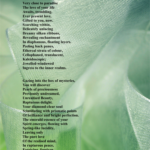 BIGGER PICTURE
BIGGER PICTURE
I'm prompted, even provoked, today by the horror and human helplessness in the face of what's happening in Japan and the Pacific. In spite of being probably the best prepared country in the world for such events, there's little or nothing that can be done about the repercussions.
It's easy to get wrapped up in the mundanities of life, fretting about details in the moment. Then something massive comes along and refocuses the attention in a much bigger arena and we realise what minute specks we are.
This photo of the earth as a pale blue dot, taken from Voyager in 1990 from around 6 billion kilometres away shows just what a tiny presence we really have in the universe.
FRAGILE HUMAN ENDEAVOURS
We are reminded also how fragile our human endeavours are in the face of natural forces. The empathetic feelings evoked by today's earthquake in Japan, with the Tsunamis relentlessly wiping out careful human constructions and carrying them off in epic tides that resemble a science fiction monster devouring huge objects in black treacly horror points up our physical impermanence.
Someone on TV said that he didn't think the Japan earthquake was connected to the recent New Zealand Christchurch earthquake. What? All that shifting, seething, abrading rock, lava and heat under the ocean, those faultlines along the Pacific Rim that make it the most volatile area for seismic activity on earth – not connected?
To me, it's all connected, and it's all moving… all the time.
I love Carl Sagan's account below. A moving experience and very timely. No further words needed from me.
PALE BLUE DOT
Here's the transcript:
Look again at that dot. That’s here. That’s home. That’s us. On it everyone you love, everyone you know, everyone you ever heard of, every human being who ever was, lived out their lives. The aggregate of our joy and suffering, thousands of confident religions, ideologies, and economic doctrines, every hunter and forager, every hero and coward, every creator and destroyer of civilization, every king and peasant, every young couple in love, every mother and father, hopeful child, inventor and explorer, every teacher of morals, every corrupt politician, every “superstar,” every “supreme leader,” every saint and sinner in the history of our species lived there-on a mote of dust suspended in a sunbeam.
The Earth is a very small stage in a vast cosmic arena. Think of the rivers of blood spilled by all those generals and emperors so that, in glory and triumph, they could become the momentary masters of a fraction of a dot. Think of the endless cruelties visited by the inhabitants of one corner of this pixel on the scarcely distinguishable inhabitants of some other corner, how frequent their misunderstandings, how eager they are to kill one another, how fervent their hatreds.
Our posturings, our imagined self-importance, the delusion that we have some privileged position in the Universe, are challenged by this point of pale light. Our planet is a lonely speck in the great enveloping cosmic dark. In our obscurity, in all this vastness, there is no hint that help will come from elsewhere to save us from ourselves.
The Earth is the only world known so far to harbor life. There is nowhere else, at least in the near future, to which our species could migrate. Visit, yes. Settle, not yet. Like it or not, for the moment the Earth is where we make our stand.
It has been said that astronomy is a humbling and character-building experience. There is perhaps no better demonstration of the folly of human conceits than this distant image of our tiny world. To me, it underscores our responsibility to deal more kindly with one another, and to preserve and cherish the pale blue dot, the only home we’ve ever known.
Carl Sagan (November 9, 1934 – December 20, 1996)


